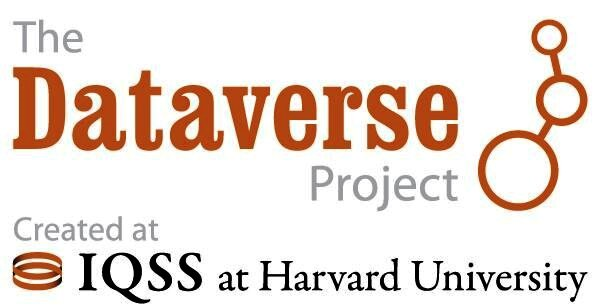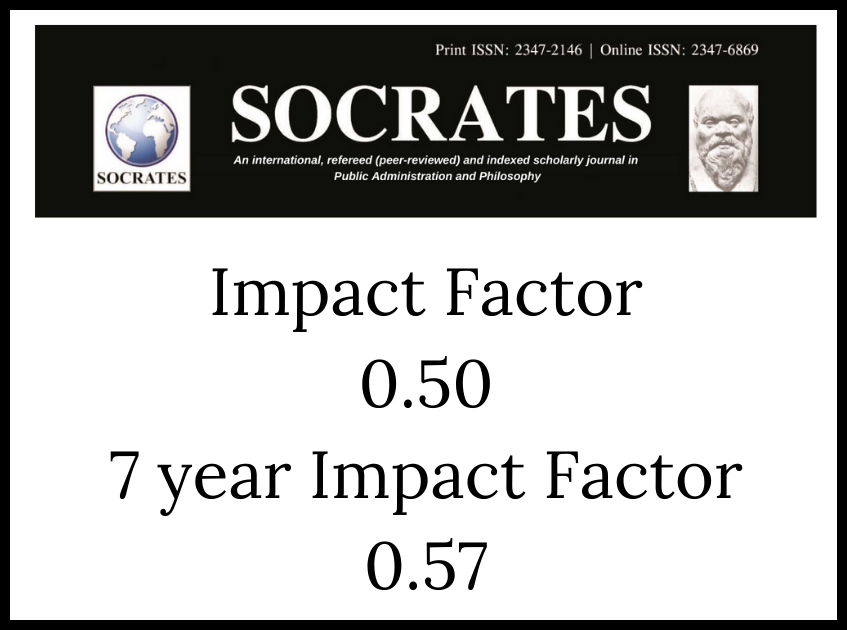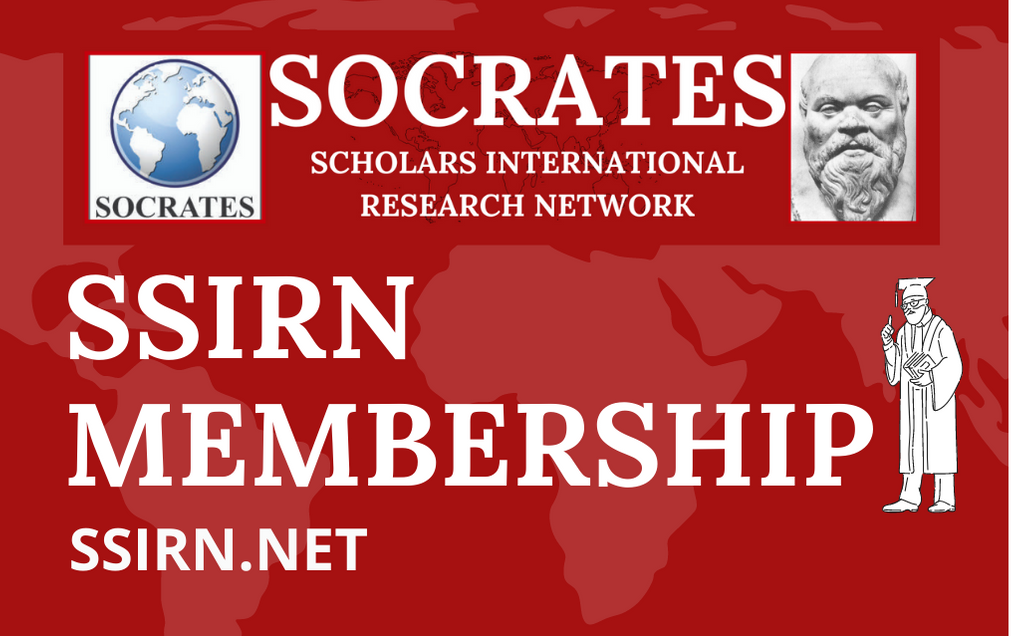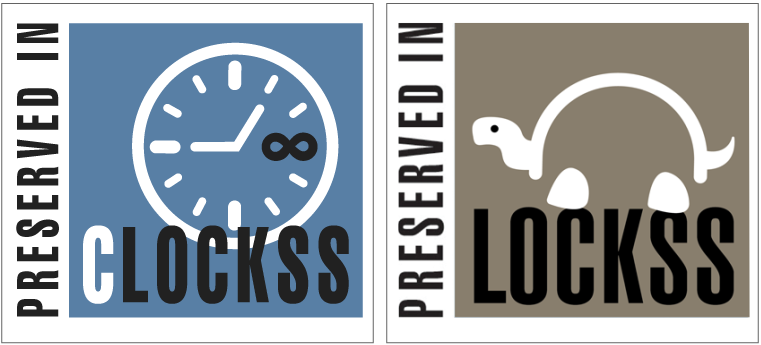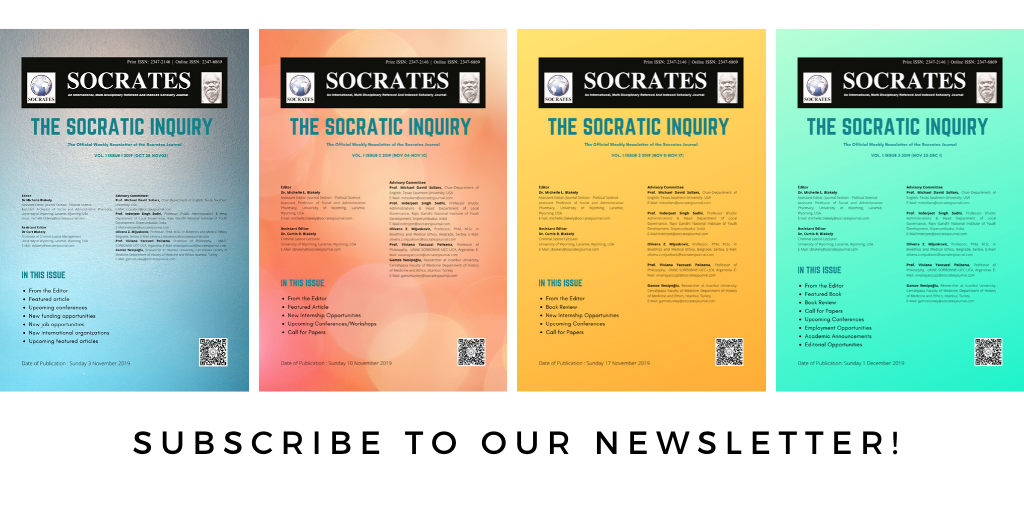The Essence of E-Governance in the Modern Era of Indian Public Administration Today
Keywords:
Public Administration, E-Governance, Information Technology and IndiaAbstract
In today's society the pace of change is immensely faster, and it will only continue to accelerate more in near future. Organizations and people that don't embrace change are bound to lose ground and remain stagnate. Thus, as an eventual consequence every government in the modern world has started imparting changes in the administration in order to cope with the altering circumstances around. The traditional pattern and processes of administration have undergone critical analysis by this time. Its excessive dependence on bureaucracy, hierarchy, rules and regulations was proved to be ineffective in delivering proper services to the citizens and when the twenty first century was seen to be characterised by the impact of globalization which has the potential to transform the social, cultural, economic and political arena worldwide in one way or another, the net effect is the need for change and innovation in the delivery of public services. Since 1990s, the concept and practice “reinventing government? has been getting much attention among the advocacy for transforming the public administration. The concept of 'good governance' as a result emerged in 1989 through a World Bank Report and thereafter the objective of attaining 'good governance' through various ways of 're-inventing' government started gaining much consideration. This paper attempts to trace the essence of e-government in the modern era of Indian Public Administration today as another new paradigm shift is in the offspring and slowly becoming distinct from the amorphous shape of Public Administration in the Indian context with the ICT-blessed governance, or e-Governance.
Downloads
Metrics
References
Amreshwar, Avasthi, A. & Maheshwari, S. (1993). Public administration in India. Agra: Lakshmi Narain Agarwal.
Basu, R. (2004). Public administration: Concepts and theories. New Delhi: Sterling Publishers Private
Bhatnagar Subhash (2004), “e-government from vision to implementation” sage publications, [2] Dey, Bata K. (2000), “E-governance in India: Problems, Challenges and Opportunities – A Futures Vision”, Indian Journal of Public Administration, Vol. XLVI, No. 3.
Bhattacharya, M. (1997). Restructuring Public Administration. New Delhi: Jawahar Publishers and Distributors
Bidyut, Chakrabarty, Bhattacharya.M.(2003). Public Administration: A Reader. New Delhi: Oxford, 2003.
Chakrabarty, Bidyut (2007). Reinventing Public Administration: The Indian Experience, New Delhi: Orient Longman.
Chaturvedi, T.N. (2000). Fifty Years on Indian Administration: Retrospect and Prospects. New Delhi: Indian Institute of Public Administration.
Dawes, S. S. (2008). The Evolution and Continuing Challenges of E-Governance. Public Administration Review, 86-100.
Deepak G. (2007).http://egovindia.wordpress.com/2007/04/22Nation al-Policy-on egovernance-required
e-Governance - Strategies for Today, Vision for Future: egovindia.org . (2016). Egovindia.org. Retrieved from http://www.egovindia.org/egovportals.html
epot.pdf, pg no. 348, 350
EVOLUTION OF PUBLIC ADMINISTRATION AS A DISCIPLINE AND ITS PRESENT STATUS. (2010). ILLUMINATION IAS. Retrieved , from https://blessan.wordpress.com/2010/08/21/evolution-of-public-administration-as-a-discipline-and-its-present-status/
Goel, S.L. (2007) Good Governance: An Integral Approach. Delhi: Deep and Deep Publishers
Grönlund, Å. (2004) Introducing e-GOV: History, Definitions and Issues. Communications of the Association for Information Systems.
Gupta, M.P. (2004) Towards E-Government Management Challenges. Tata McGraw-Hill
http://indiaegovernance.blogspot.in/2008/03/object-of-e-governance.html
Implementing the President’s Management Agenda for E-Government. E-Government Strategy(online resource)
Kochhar, S. & G. Dhanjal. (2004). From governance to e-governance: An initial assessment of some of India’s best projects, Technical Report, New Delhi: Skoch Consultancy Services.
National Conference on Public Administration in the 21st Century, Bava, N., & Indian Institute of Public Administration. (2004). Public administration in the 21st century. New Delhi: Kanishka Publishers, Distributors.
Prabhu, C. (2012) E-Governance: Concepts and Case Studies. New Delhi: PHI Learning Private Limited <www.egovindia.org/egovportals.html>
S. P. Naidu. (2013).Public Administration: Concepts and Theories, New Age International (P) Limited, New Delhi.
Self, Peter.(1981).Administrative theories and Practices: An Enquiry into the Structure and Processes of Modern Government, New Delhi: S. Chand.'
Sheridan, W., and Riley, T.B. (2006) Commonwealth Centre for e-Governance, e-Gov Monitor, Monday, 3 July, 2006.
WEF Global Information Technology Report. http://www.weforum.org/pdf/gitr/2009/fullr
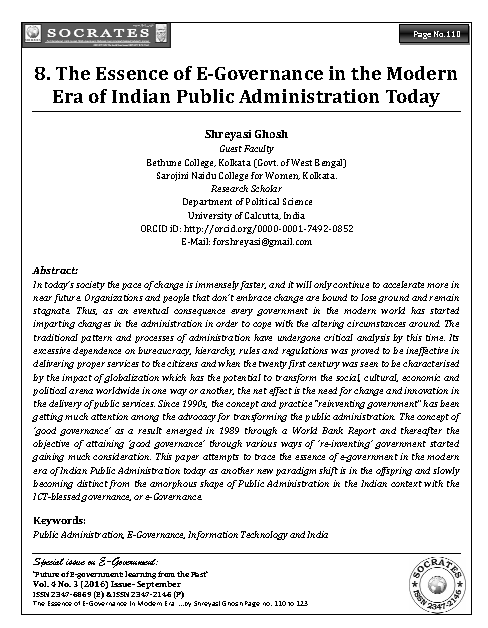
Downloads
Published
How to Cite
Issue
Section
License
Revised Copyright/CC license that applies to all the articles published after 05-02-2017
Attribution-NonCommercial 4.0 International (CC BY-NC 4.0)

Copyright/CC license that applies to all the articles published before 05-02-2017
Attribution-Non Commercial-No Derivatives 4.0 International (CC BY-NC-ND 4.0)

Author(s) will retain all the right except commercial and re-publishing rights. In the case of re-publishing, they will have to obtain written permission from the journal. Additional licensing agreements (Creative Commons licenses) grants rights to readers to copy, distribute, display and perform the work as long as you give the original author(s) credit, they can not use the works for commercial purposes and are not allowed to alter, transform, or build upon the work. For any reuse or distribution, readers and users must make clear to others the license terms of this work. Any of these conditions can be waived if you get permission from the copyright holders. Nothing in this license impairs or restricts the authors’ rights. To view a copy of this license, visit http://creativecommons.org/licenses/by-nc-nd/4.0/ or send a letter to Creative Commons, 171 Second Street, Suite 300, San Francisco, California, 94105, USA.
Research Papers published in SOCRATES are licensed under an Attribution-NonCommercial-NoDerivatives 4.0 International (CC BY-NC-ND 4.0)

